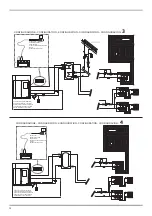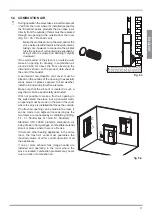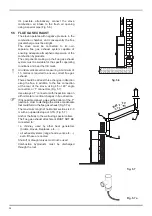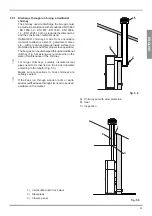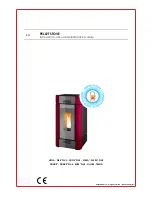
28
It’s possible, alternatively, connect the stove
combustion air intake to the fresh air opening
using a special pipe (Fig. 5.6).
5.5 FLUE GAS EXHAUST
The stove operates with negative pressure in the
FRPEXVWLRQ FKDPEHU DQG FRQVHTXHQWO\ WKH ÀXH
gas discharge must be airtight.
The stove must be connected to its own
VHSDUDWH ÀXH JDV H[KDXVW V\VWHP FDSDEOH RI
ensuring adequate atmospheric dispersion of the
combustion byproducts.
7KHFRPSRQHQWVPDNLQJXSWKHÀXHJDVH[KDXVW
V\VWHPPXVWEHVXLWDEOHIRUWKHVSHFL¿FRSHUDWLQJ
conditions and bear the CE mark.
An initial vertical section measuring a minimum of
PHWUHVLVUHTXLUHGWRHQVXUHFRUUHFWÀXHJDV
exhaust.
There should be at least three changes in direction
DORQJ WKH ÀXH LQ DGGLWLRQ WR WKH ÀXH FRQQHFWLRQ
at the rear of the stove, using 45 or 90° angle
connectors or ‘T’ connectors (Fig. 5.7).
Use always a ‘T’ connector with inspection cap on
DOOKRUL]RQWDORUYHUWLFDOFKDQJHVLQÀXHGLUHFWLRQ
If it is possible connect a pipe at the bottom of the „T“
junction in order to discharge the smoke condensate
WKDWFRXOGIRUPLQWKHÀXHJDVH[KDXVW)LJD
The maximum length of horizontal sections is 2-3
m with an upwards slope of 3-5% (Fig. 5.7).
$QFKRUWKHÀXHVWRWKHZDOOXVLQJVSHFLDOFROODUV
7KHÀXHJDVH[KDXVWDWWDFKPHQW0867127%(
connected to:
a chimney used by other heat generators
ERLOHUVVWRYHV¿UHSODFHVHWF
air exhaust systems (range hoods, vents, etc.....)
even if these are ducted.
Shut-off or draught valves must not be used.
Combustion byproducts must be discharged
through the roof.
¿J
B
B
B
MAX 2 - 3 m
C > 3 - 5%
¿J
Fig. 5.7a






